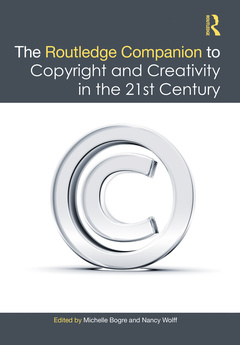The Routledge Companion to Copyright and Creativity in the 21st Century
Coordonnateurs : Bogre Michelle, Wolff Nancy

These collected chapters and interviews explore the current issues and debates about how copyright will or should adapt to meet the practices of 21st-century creators and internet users.
The book begins with an overview of copyright law basics. It is organized by parts that correspond to creative genres: Literary Works, Visual Arts, Fine Art, Music, Video Games and Virtual Worlds, Fashion, and Technology. The chapters and interviews address issues such as copyright ownership in work created by Artificial Intelligence (AI), the musical remix market, whether appropriation is ever a fair use of a copyrighted work or if it is always theft, and whether internet- based platforms should do more to deter piracy of creators? works. Each part ends with an essay explaining the significance of one or two landmark or trendsetting cases to help the reader understand the practical implications of the law.
Written to be accessible to both lay and legal audiences, this unique collection addresses contemporary legal issues that all creators need to understand and will be essential reading for artists, designers, and musicians as well as the lawyers who represent them.
Preface ; Acknowledgements ; Notes on Contributors ; I. Copyright Basics ; 1.1 Copyright Basics: What You Think You Know May Not Be True ; II. Literary Works ; 2.0. Literary Works: Chapter Introduction ; 2.1. Piracy of Books in the Digital Age ; 2.2. Is A Picture Really Worth More Than A Thousand Words? ; 2.3. Fair Use: The Judicial Mix-Up Over "A Mixed Question of Law and Fact" ; 2.4. Fair Use: The Linchpin to the Future of the Copyright Act ; 2.5. Self-Publishing Revolution: Copyright Pitfalls for Writers Who Go It Alone ; 2.6. Landmark Case ; III. Visual Arts (Photography, Illustration, Animation) ; 3.0. Visual Arts: Chapter Introduction ; 3.1. How Close Can You Get: Substantial Similarity in the Context of Works of Visual Art ; 3.2. Gorgeous Photograph, Limited Copyright ; 3.3. Copyright Concerns for Visual Journalists ; 3.4. Social Media: Use It and Lose It? ; 3.5. Landmark Case ; IV. Fine Art (Sculpture, Painting) ; 4.0. Fine Art: Chapter Introduction ; 4.1. The Art Collector’s Burden: Guiding a Collection Through the Thicket of Copyright Law ; 4.2. Protection of Street Art: Has VARA Finally Found its Métier? ; 4.3. Appropriation Art: Creating by Taking ; 4.4. Appropriation Art: Creating by Using ; 4.5. Authorship and Authenticity: Banksy ; 4.6. Landmark Case ; V. Music ; 5.0. Music: Chapter Introduction ; 5.1. A Remix Compulsory Licensing Regime for Music Mashups ; 5.2. Sampling: Using Recordings as Musical Instruments ; 5.3. Subconscious Copying: From George Harrison to Sam Smith, a Song Gets in Your Head and Winds up in a New Song ; 5.4. Why Music Should Not Be Free: The Battle for Survival ; 5.5. Music, Deposit Copies, and Unanswered Questions After Skidmore v. Led Zeppelin ; 5.6. Co-Authorship: A Little Help Can Lead to a Big Headache ; 5.7. Landmark Case ; VI. Video Games and Virtual Worlds ; 6.0. Video Games and Virtual Worlds: Chapter Introduction ; 6.1. Video Games and Virtual Worlds: Recreating the World and Fighting A Dragon In It ; 6.2. Virtual Property & Virtual Currency ; 6.3. Press "X" To Open: Pandora’s Loot Box ; 6.4. Landmark Case ; VII. Fashion ; 7.0. Fashion: Chapter Introduction ; 7.1. Buyer Beware: Copyright Issues in the Fashion Industry ; 7.2. Hermes in Hermès: Searching for Boundaries in Non-Traditional Trademarks and Copyrights ; 7.3. Idea/Expression Dichotomy: If the Belt Buckle Fits, You Can Copy It ; 7.4. Landmark Case ; VIII. Technology ; 8.0. Technology: Chapter Introduction ; 8.1. The DMCA Safe Harbor: User-Generated Content ; 8.2. The DMCA Safe Harbor: Policy and Practice Divided ; 8.3. Copyright Trolls: When Copyright Litigation Becomes a Business Model ; 8.4. Virtual Reality: Blending the Real World with Copying ; 8.5. Artificial Intelligence and the Future of Literary Works ; 8.6 Landmark Case ; IX. Future Copyright ; 9.1. Future of Copyright ; 9.2. What’s Next: Predictions from Interviewees and Authors
Michelle Bogre, Esq., is a Professor Emerita from Parsons School of Design in New York City, where she taught photography and copyright law for artists and designers. She is the author of three other books: Photography As Activism: Images for Social Change; Photography 4.0: A Teaching Guide for the 21st Century; and, her newest, Documentary Photography Reconsidered: Theory, History and Practice.
Nancy Wolff is a partner at the bi-coastal firm Cowan, DeBaets, Abrahams & Sheppard, LLP. She is co-chair of the firm’s litigation department, Past President of the Copyright Society of the USA (CSUSA), and member of the American Bar Association (ABA) IP Task Force on Copyright Reform. She is the author of Best Practices in Image Licensing, published in the Licensing Journal, and The Professional Photographers Legal Handbook.
Date de parution : 05-2024
17.8x25.4 cm
Date de parution : 11-2020
17.8x25.4 cm
Thèmes de The Routledge Companion to Copyright and Creativity in... :
Mots-clés :
DMCA Safe Harbor; Game Developers; copyright; Copyrighted Work; United States copyright law; Violate; intellectual property rights; Statutory Damages; fair use; Takedown Notices; literary works; Copyright Owners; illustration; Copyright Office; fine art; Copyright Infringement Claim; video games; Copyright Protection; gaming; Safe Harbor; fashion; Cheerleader Uniforms; music; Authors Guild; film; Appropriation Art; photography; Vara; animation; Summary Judgment; DCMA; Georges Braque; open source; AI System; creative commons; Deposit Copies; licensing; District Court Granted Summary Judgment; intellectual property; Copyright Trolls; copyright law; Ai Technology; 21st-century creators; Circuit Courts; Internet-based platforms; Trade Dress; Artificial Intelligence; Acuff Rose Music; Copyright ownership
